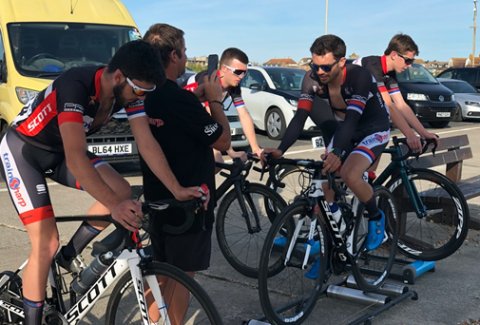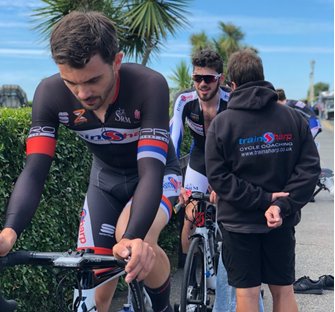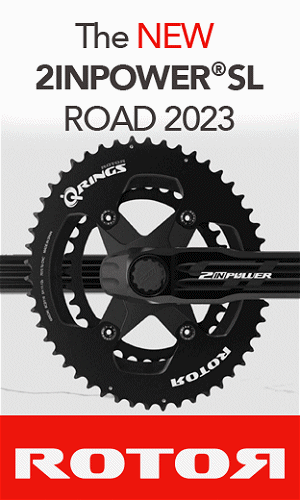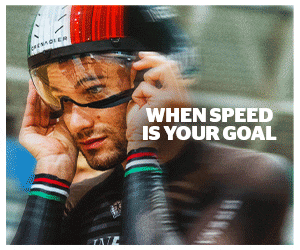Warming up for a bike race is something most, if not all bike riders will do before a race but why do you need to warm up? – Alex Welburn from trainSharp explores the subject here on VeloUK
 |
Coaching: Why you should warm-up before a race
Brought to you by trainSharp
Whether you are at an early morning time trial or a at the local cross race on a winter’s morning, the sound of turbo’s and rollers whining away are a familiar affair. We also see ‘warm up’s’ placed in training sessions. But what do we know about them? Do they help us maximise our performance? Or are we simply wasting energy that could be used for a race or training session?
Why warm up?
When exploring warm-ups, you may hear analogies such as, a racing car driver will never go full throttle without letting the engine warm up. So why are we doing a warm-up, what is the purpose?
Warming up the muscles/lungs/body is critical to ensuring you optimise your performance, whether you are a local club rider or a world tour cyclist, a warm-up will be beneficial to all. There are a variety of physiological responses that we are looking to induce. One of those being a change in your VO2 kinetics, a term you may not have come across before which is the term we use to measure how quickly your body reacts with a change it its breathing rate in response to the onset of exercise.
One of the benefits of an effective warm-up, is that it up can speed up your VO2 kinetics so you can meet the oxygen demands at a much greater rate, simply meaning your breathing response rate will be much quicker, which means your body won’t have to play catch up if you decided not to warm-up.
… continued after advert
Warming up will literally help warm you up, specifically your muscles, which will help your muscles to contract and ultimately produce power. It is known that warm muscles will help improve your peak power capabilities. In fact, for the 2012 London Olympics, Loughborough University in partnership with British Cycling developed ‘Hot Pants’. These were bespoke designed for each rider with a zip up tights that had a heating element which allows them to maintain a particular temperature in-between their events, they were fast and easy to take off. We took home 12 medals that year in cycling events…
So, as you warm-up, your muscles will also produce heat, and this increase in muscle temperature helps create an environment in which the metabolic enzymes work optimally. So if you were not to warm up, you would be playing catch up, which if you are looking to perform, you want to be ready from the word go.
Not only does it help from a physiological point, but it allows you to mentally prepare for the session, or race. It helps create a routine for yourself, where you can focus on the task at hand. It can be a case of getting the music going and having that playlist that gets you fired up. Within racing, it can be a key component to your pre performance routine, so you know when it’s warm-up it time, it is time to focus.
As a general rule of thumb, the shorter the effort the more intense the warm-up needs to be, but that doesn’t mean you can’t just stick to one main warm up and add a few little different parts to it. Research does suggest that including periods of intensity that you will be at during your main part (Race/training session) can help optimise your performance.
How to warm up?
As a suggested warm-up, I would recommend, doing 5-10 minutes at a very light intensity around Zone 1 just to get the legs spinning around 50-65 % of your functional threshold power (FTP), if you use that as a reference.
Then aim to work through the zones so 5 minutes into Zone 2 (65-75% of FTP) working your way through the zone then move into zone 3 (75-85% of FTP) and if you are doing a more intense event such as a TT or Cyclo-Cross race, I would then advise working up to your 20 minute power in the last minute to get everything firing. Complete five minutes again at Zone 1 and include 3 x 30 second efforts with a fast and high cadence at approximately your VO2 max power which can be around 120 % of your FTP. If you are criterium racing, you can change these to add in a 3 short sprints with around 60 seconds recovery separating the efforts. This is where you can vary your warmup to suit your needs as they should certainly be individual.
A simple, short example warm up – Progressive riding through the training zones.
Duration Intensity 5 minutes Zone 1 5 Minutes Zone 2 3 Minutes Zone 3 2 Minutes Zone 4 1 Minute Zone 1 1 Minute Zone 5 5 Minutes Zone 1 Total – 22 Minutes
Overall – implementing a warmup can really help you optimise your performance so you can perform at the highest possible level. If you would like to talk about how we can help prepare you, feel free to get in touch with us at paul@trainsharp.co.uk.
Website: www.trainsharpcyclecoaching.co.uk
Cycle Division’s Shop
Send your results as well as club, team & event news here
Other Results on VeloUK (including reports containing results)
- Features, Reports, Results
- RR Result: Radnorshire Road Race
- Crit Result: Full Gas Spring Cup #1
- Events: 18th Rutland-Melton CiCLE Classic Route
- Events: Nigel Harrop Memorial Road Race
- TT Result: VTTA East Midlands 10m TT
- TT Result: East Sussex CA 25m TT
- TT Result: VTTA Kent 30m Time Trial
- TT Result: Shaftesbury CC 25m TT
- TT Result: CTT Classic Series 3
- TT Result: Diss & District CC 25m TT
- TT Result: Icknield RC 20m TT
- TT Result: Royal Albert CC 10m TT
- TT Result: Southport CC 15m TT
- Crit Result: Milton Keynes Development Races
- This weekend: 18th CiCLE Classic UCI 1.2
- The Dave Peck Memorial: British Women’s Team Cup 2
- BMCR RESULT: National A/B RR and Echelon Cycles Stallard races
- RR Result: PB Performance U23 Nat Series RR
- RR Result: Proper Northern Road Races (Oakenclough)
- RR Result: Drummond Trophy
- Crit Result: Thruxton Tuesday Series 2
- Crit Result: CDPP Sport Crit Series 1
- Crit Result: SACA Salt Ayre Series 1
- Crit Result: Portsmouth Evening Circuits 4
- Crit Result: Rowe & King Maindy 1
- Q&A: Charlie Abraham (Lee Valley Youth Junior Cycling Team)
- Events: SSSCCRRL Road Race League
- Youth Result: Isle of Man Youth League
- Youth Result: Lawford Youth Series (Curborough) #2
- Crit Result: Full Gas Summer Circuit Series #2
- Crit Result: Ride Flux Spring Crit series #2
- Youth Result: Maindy Flyers Freewheel League 1
- Ribble Collective: Ride More in ’24
- Crit Result: Tameside Cycling Development Circuit Races 1
- Crit Result: 2024 West Thames League 1
- Startlist: The Drummond Trophy
- TT Result: VTTA Surrey/Sussex 10 mile TT
- EVENTS: Proper Northern Road Races – Round 2 Oakenclough
- TTT Result: Scorton TTT
- TT Result: Manchester & District TTA 25m TT
Other News on VeloUK
- Events: 18th Rutland-Melton CiCLE Classic Route
- Events: Nigel Harrop Memorial Road Race
- This weekend: 18th CiCLE Classic UCI 1.2
- Events: SSSCCRRL Road Race League
- Ribble Collective: Ride More in ’24
- Startlist: The Drummond Trophy
- EVENTS: Proper Northern Road Races – Round 2 Oakenclough
- Events: Dave Peck Memorial
- News: Women’s Tour of Britain
- Startlist: PB Performance Espoirs Road Race
- East Cleveland Classic: Saint Piran Team
- News: New kit for Ribble Rebellion Riders
- Events: Halesowen Friday Track Nights
- Team News: Ribble Rebellion off to the USA
- News: Pedal Club Lunch (March)
- Rider News: Winning start for Billy Ladle
- News: CiCLE Classic 2024
- Startlist: Stars of the SW Men’s U23 RR
- Startlist: Danum Trophy 2024 (Nat B)
- Startlists: London Dynamo Road Races
- Startlist: La Fleche Waltonne Road Races (BMCR)
- Meet Ribble HoloRider
- Startlists: East Cleveland Classic 2024
- Former Winners: Lincoln Grand Prix
- Chris Lawless Joins Saint Piran Team
- Paracycling Track Worlds Day 4
- Para CyclingWorlds Final Day
- Startlist: National Youth Circuit Series Rd 1
- Report/Result: Azets Spring Classic
- Startlists: RCR Fat Creations Road Races
- Startlist: Capernwray Road Race (March 31)
- Team Report: Fensham Howes MAS Design Junior Team
- Team Report: CiCLE Classic Junior Men
- RIDER REPORTS – Zoe Parker (Solihull CC)
- GB News: Two World Titles for GB at Para Worlds
- Team News: Alba Development Road Team
- News: British Road Champs Return to NE
- THIS WEEKEND: Peaks Two Day is Back!
- News: Laura Kenny Retires
- Team News: Lee Valley Youth Cycling Team






















